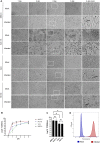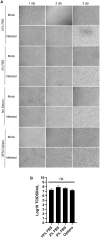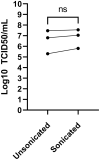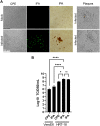Optimizing human coronavirus OC43 growth and titration
- PMID: 35833016
- PMCID: PMC9272819
- DOI: 10.7717/peerj.13721
Optimizing human coronavirus OC43 growth and titration
Abstract
Coronaviruses have been at the forefront of the news for the last 2 years. Unfortunately, SARS-CoV-2, the etiologic agent for the COVID-19 pandemic, must be manipulated in biosecurity level 3 settings, which significantly limits research. Meanwhile, several less pathogenic human coronaviruses (HCoV) exist and can be studied in much more common biosafety level 2 laboratories. Among them, HCoV-OC43 is a good surrogate candidate for SARS-CoV-2 since both are phylogenetically related human Betacoronaviruses. However, one issue has been the lack of standardized means among laboratories to propagate and titer this less virulent coronavirus. The present study probes the optimal parameters to propagate HCoV-OC43. First, testing of five different cell lines (MRC-5, Huh7.5, Vero, HCT-8, HRT-18) indicated that the physiologically relevant MRC-5 human lung cell line produced among the highest viral titers. HRT-18 may however be an interesting alternative as they are quick growing cells that also led to higher viral titers and a better tropism for various HCoV-OC43 variants. We also probed the impact of serum and temperature during viral expansion and confirmed that the normal temperature of the upper respiratory track (33 °C) improves viral yields over the typical 37 °C used to grow many other viruses. Meanwhile, we did not notice any evidence that serum concentrations significantly affected the virus but interestingly noted that the virus grew quite efficiently in a serum-free media formulation. Meanwhile sonication of viral stocks somewhat improved viral titers. Four titration methods (plaque assays, TCID50-CPE, TCID50-IFA and TCID50-IPA) were also probed using two cell lines (VeroE6 and HRT-18). In our hands, plaque assays proved unreliable and quantification of the virus by scoring CPE positive wells was significantly less sensitive than antibody-based assays (IFA and IPA). While the latter methods were equally sensitive, we favor the TCID50-IPA method since simpler, faster and cheaper than the IFA protocol. Moreover, the HRT-18 cells appeared more sensitive to quantify the virus. Perhaps most importantly, these optimized protocols routinely led to high titer viral stocks in the order of 108 TCID50/ml magnitude, which should fulfill the requirements of most experimental settings.
Keywords: COVID; HCoV-OC43; OC43; Propagation; SARS-CoV-2; Titration; Viral stocks.
© 2022 Savoie and Lippé.
Conflict of interest statement
The authors declare that they have no competing interests.
Figures






Similar articles
-
Comparative study of the propagation and plaque titration conditions for human coronavirus OC43 as a surrogate for SARS-CoV-2.Arch Virol. 2024 Oct 4;169(10):214. doi: 10.1007/s00705-024-06146-9. Arch Virol. 2024. PMID: 39365483
-
Improving human coronavirus OC43 (HCoV-OC43) research comparability in studies using HCoV-OC43 as a surrogate for SARS-CoV-2.J Virol Methods. 2022 Jan;299:114317. doi: 10.1016/j.jviromet.2021.114317. Epub 2021 Oct 9. J Virol Methods. 2022. PMID: 34634321 Free PMC article.
-
A Cytopathic Effect-Based Tissue Culture Method for HCoV-OC43 Titration Using TMPRSS2-Expressing VeroE6 Cells.mSphere. 2021 May 12;6(3):e00159-21. doi: 10.1128/mSphere.00159-21. mSphere. 2021. PMID: 33980675 Free PMC article.
-
Human Coronavirus OC43 as a Low-Risk Model to Study COVID-19.Viruses. 2023 Feb 20;15(2):578. doi: 10.3390/v15020578. Viruses. 2023. PMID: 36851792 Free PMC article. Review.
-
An overview on the seven pathogenic human coronaviruses.Rev Med Virol. 2022 Mar;32(2):e2282. doi: 10.1002/rmv.2282. Epub 2021 Aug 2. Rev Med Virol. 2022. PMID: 34339073 Review.
Cited by
-
The antipsychotic drug lurasidone inhibits coronaviruses by affecting multiple targets.Front Cell Infect Microbiol. 2024 Nov 25;14:1487604. doi: 10.3389/fcimb.2024.1487604. eCollection 2024. Front Cell Infect Microbiol. 2024. PMID: 39654978 Free PMC article.
-
Comprehensive proteomic analysis of HCoV-OC43 virions and virus-modulated extracellular vesicles.J Virol. 2024 Jul 23;98(7):e0085024. doi: 10.1128/jvi.00850-24. Epub 2024 Jul 2. J Virol. 2024. PMID: 38953378 Free PMC article.
-
Germicidal efficacy of continuous and pulsed ultraviolet-C radiation on pathogen models and SARS-CoV-2.Photochem Photobiol Sci. 2024 Feb;23(2):339-354. doi: 10.1007/s43630-023-00521-2. Epub 2024 Feb 2. Photochem Photobiol Sci. 2024. PMID: 38308169
-
Comparative study of the propagation and plaque titration conditions for human coronavirus OC43 as a surrogate for SARS-CoV-2.Arch Virol. 2024 Oct 4;169(10):214. doi: 10.1007/s00705-024-06146-9. Arch Virol. 2024. PMID: 39365483
-
Development of a general anti-viral therapeutic using cholestosome technology to exploit inhibition of intracellular viral production.Biochem Biophys Rep. 2025 Jan 23;41:101922. doi: 10.1016/j.bbrep.2025.101922. eCollection 2025 Mar. Biochem Biophys Rep. 2025. PMID: 39926208 Free PMC article.
References
-
- Chu H, Chan JF-W, Yuen TT-T, Shuai H, Yuan S, Wang Y, Hu B, Yip CC-Y, Tsang JO-L, Huang X, Chai Y, Yang D, Hou Y, Chik KK-H, Zhang X, Fung AY-F, Tsoi H-W, Cai J-P, Chan W-M, Ip JD, Chu AW-H, Zhou J, Lung DC, Kok K-H, To KK-W, Tsang OT-Y, Chan K-H, Yuen K-Y. Comparative tropism, replication kinetics, and cell damage profiling of SARS-CoV-2 and SARS-CoV with implications for clinical manifestations, transmissibility, and laboratory studies of COVID-19: an observational study. The Lancet Microbe. 2020;1(1):e14–e23. doi: 10.1016/S2666-5247(20)30004-5. - DOI - PMC - PubMed
Publication types
MeSH terms
Grants and funding
LinkOut - more resources
Full Text Sources
Medical
Research Materials
Miscellaneous

